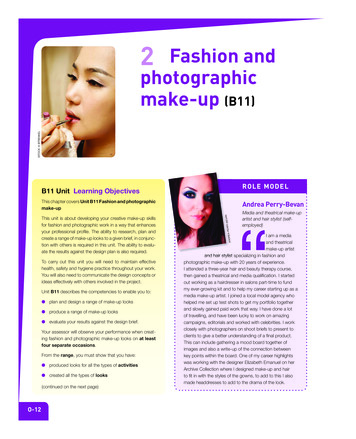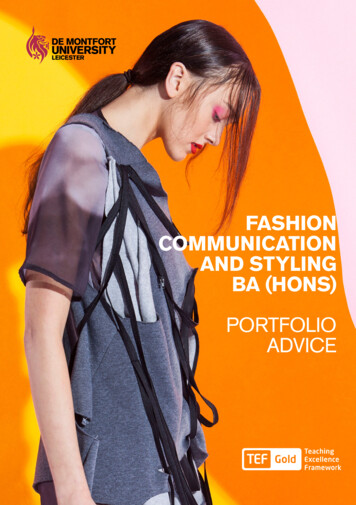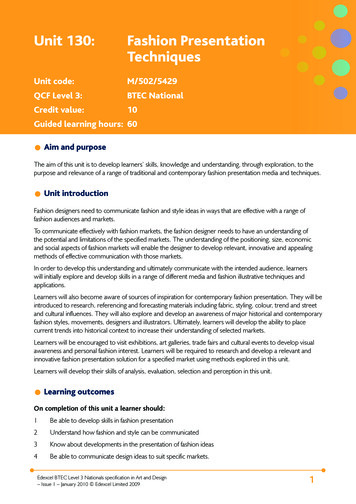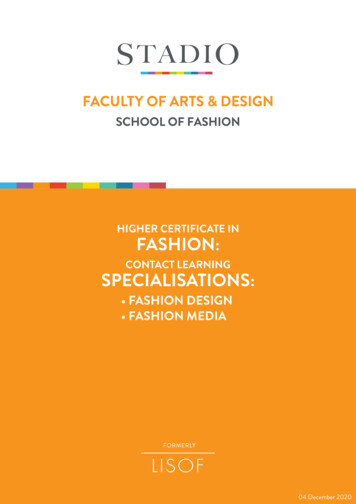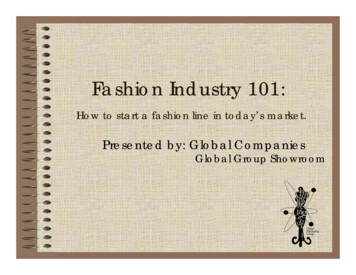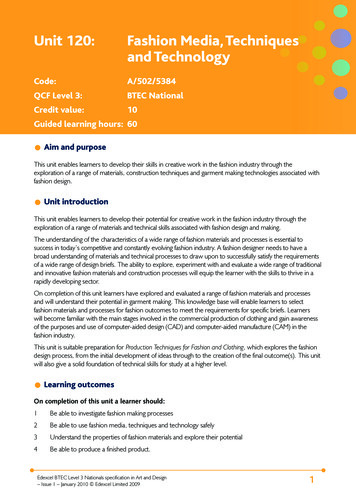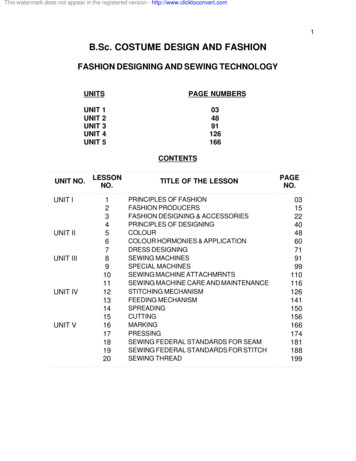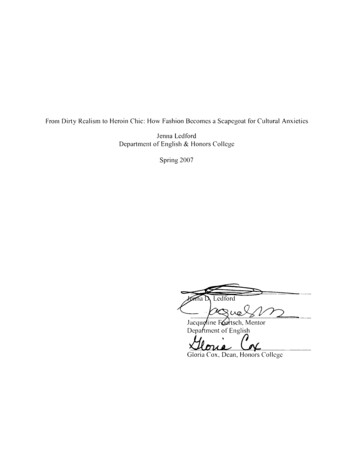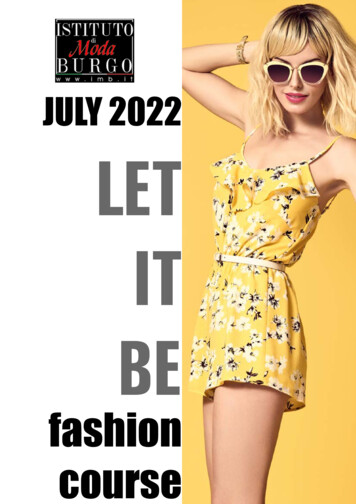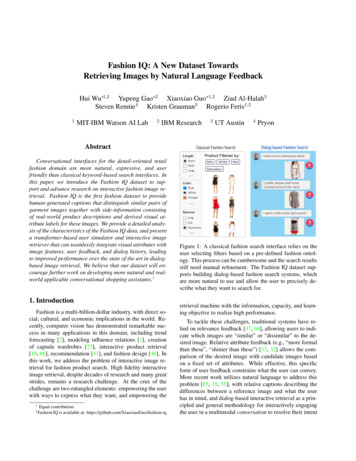
Transcription
Fashion IQ: A New Dataset TowardsRetrieving Images by Natural Language FeedbackHui Wu*1,2 Yupeng Gao 2 Xiaoxiao Guo 1,2 Ziad Al-Halah3Steven Rennie4 Kristen Grauman3 Rogerio Feris1,21MIT-IBM Watson AI Lab2IBM ResearchAbstractConversational interfaces for the detail-oriented retailfashion domain are more natural, expressive, and userfriendly than classical keyword-based search interfaces. Inthis paper, we introduce the Fashion IQ dataset to support and advance research on interactive fashion image retrieval. Fashion IQ is the first fashion dataset to providehuman-generated captions that distinguish similar pairs ofgarment images together with side-information consistingof real-world product descriptions and derived visual attribute labels for these images. We provide a detailed analysis of the characteristics of the Fashion IQ data, and presenta transformer-based user simulator and interactive imageretriever that can seamlessly integrate visual attributes withimage features, user feedback, and dialog history, leadingto improved performance over the state of the art in dialogbased image retrieval. We believe that our dataset will encourage further work on developing more natural and realworld applicable conversational shopping assistants.11. IntroductionFashion is a multi-billion-dollar industry, with direct social, cultural, and economic implications in the world. Recently, computer vision has demonstrated remarkable success in many applications in this domain, including trendforecasting [2], modeling influence relations [1], creationof capsule wardrobes [23], interactive product retrieval[18, 68], recommendation [41], and fashion design [46]. Inthis work, we address the problem of interactive image retrieval for fashion product search. High fidelity interactiveimage retrieval, despite decades of research and many greatstrides, remains a research challenge. At the crux of thechallenge are two entangled elements: empowering the userwith ways to express what they want, and empowering the* Equal contribution.1 Fashion IQ is available at:https://github.com/XiaoxiaoGuo/fashion-iq3UT AustinClassical Fashion SearchLengthShortMidiLongProduct Filtered by:MiniWhite4PryonDialog-based Fashion SearchI want a mini sleeveless dressRedSleeveless ColorBlueI prefer stripes and morecovered around the neckWhiteOrange SleevesI want a little more red accentlong3/4Sleeveless Figure 1: A classical fashion search interface relies on theuser selecting filters based on a pre-defined fashion ontology. This process can be cumbersome and the search resultsstill need manual refinement. The Fashion IQ dataset supports building dialog-based fashion search systems, whichare more natural to use and allow the user to precisely describe what they want to search for.retrieval machine with the information, capacity, and learning objective to realize high performance.To tackle these challenges, traditional systems have relied on relevance feedback [47, 68], allowing users to indicate which images are “similar” or “dissimilar” to the desired image. Relative attribute feedback (e.g., “more formalthan these”, “shinier than these”) [33, 32] allows the comparison of the desired image with candidate images basedon a fixed set of attributes. While effective, this specificform of user feedback constrains what the user can convey.More recent work utilizes natural language to address thisproblem [65, 18, 55], with relative captions describing thedifferences between a reference image and what the userhas in mind, and dialog-based interactive retrieval as a principled and general methodology for interactively engagingthe user in a multimodal conversation to resolve their intent
Single-shot RetrievalUser Model / Relative Captioning“More ruffles on topand is beige”“The top hasstripes and islong sleeved”RelativeCaptionerUser model: “Thetop has stripes andis long sleeved”Human: “The top isorange in color andmore flowy”“is strapless and morefitted”Fashion IQ RetrieverRetrieverUser model: “Thetop has stripes andis long sleeved”Human: “The top isorange in colorand more flowy”Shopping AssistantRetrieverUser Model FeedbackHuman FeedbackUser Model FeedbackHuman FeedbackApplicationDialog-based RetrievalTasksFigure 2: Fashion IQ can be used in three scenarios: user modeling based on relative captioning, and single-shot as well asdialog-based retrieval. Fashion IQ uniquely provides both annotated user feedback (black font) and visual attributes derivedfrom real-world product data (dashed boxes) for system training.[18]. When empowered with natural language feedback,the user is not bound to a pre-defined set of attributes, andcan communicate compound and more specific details during each query, which leads to more effective retrieval. Forexample, with the common attribute-based interface (Figure 1 left) the user can only define what kind of attributesthe garment has (e.g., white, sleeveless, mini), however withinteractive and relative natural language feedback (Figure 1right) the user can use comparative forms (e.g., more covered, brighter) and fine-grained compound attribute descriptions (e.g., red accent at the bottom, narrower at the hips).While this recent work represents great progress, severalimportant questions remain. In real-world fashion productcatalogs, images are often associated with side information,which in the wild varies greatly in format and informationcontent, and can often be acquired at large scale with lowcost. Descriptive representations such as attributes can often be extracted from this data, and form a strong basis forgenerating stronger image captions [71, 66, 70] and moreeffective image retrieval [25, 5, 51, 34]. How such side information interacts with natural language user inputs to improve the state of the art dialog-based image retrieval systems are important open research questions. Furthermore, achallenge with implementing dialog-interface image searchsystems is that currently conversational systems typicallyrequire cumbersome hand-engineering and/or large-scaledialog data [35, 6]. In this paper, we investigate the extentto which side information can alleviate these issues, and explore ways to incorporate side information in the form ofvisual attributes into model training to improve interactiveimage retrieval. This represents an important step towardthe ultimate goal of constructing commercial-grade conversational interfaces with much less data and effort, and muchwider real-world applicability.Toward this end, we contribute a new dataset, Fashion Interactive Queries (Fashion IQ). Fashion IQ is distinct fromexisting fashion image datasets (see Figure 4) in that ituniquely enables joint modeling of natural language feedback and side information to realize effective and practicalimage retrieval systems. As we illustrate in Figure 2, thereare two main settings to utilize Fashion IQ to drive progresson developing more effective interfaces for image retrieval:single-shot retrieval and dialog-based retrieval. In both settings, the user can communicate their fine-grained searchintent via natural language relative feedback. The difference of the two settings is that dialog-based retrieval canprogressively improve the retrieval results over the interaction rounds. Fashion IQ also enables relative captioning,which we leverage as a user model to efficiently generate alarge amount of low-cost training data, to further improvetraining interactive fashion retrieval systems.2To summarize, our main contributions are as follows: We introduce a novel dataset, Fashion IQ, a publiclyavailable resource for advancing research on conversational fashion retrieval. Fashion IQ is the first fashiondataset that includes both human-written relative captions that have been annotated for similar pairs of images,and the associated real-world product descriptions and attribute labels as side information. We present a transformer-based user simulator and interactive image retriever that can seamlessly leverage multimodal inputs (images, natural language feedback, andattributes) during training, and leads to significantly improved performance. Through the use of self-attention,these models consolidate the traditional components ofuser modeling and interactive retrieval, are highly extensible, and outperform existing methods for the relativecaptioning and interactive image retrieval of fashion images on Fashion IQ.2 Relative captioning is also a standalone vision task [26, 57, 43, 15],which Fashion IQ serves as a new training and benchmarking dataset.
To the best of our knowledge, this is the first study to investigate the benefit of combining natural language userfeedback and attributes for dialog-based image retrieval,and it provides empirical evidence that incorporating attributes results in superior performance for both usermodeling and dialog-based image retrieval.2. Related WorkFashion Datasets. Many fashion datasets have been proposed over the past few years, covering different applications such as fashionability and style prediction [50, 28,22, 51], fashion image generation [46], product search andrecommendation [25, 72, 19, 41, 63], fashion apparel pixelwise segmentation [27, 74, 69], and body-diverse clothing recommendation [24]. DeepFashion [38, 16] is a largescale fashion dataset containing consumer-commercial image pairs and labels such as clothing attributes, landmarks,and segmentation masks. iMaterialist [17] is a largescale dataset with fine-grained clothing attribute annotations, while Fashionpedia [27] has both attribute labels andcorresponding pixelwise segmented regions.Unlike most existing fashion datasets used for imageretrieval, which focus on content-based or attribute-basedproduct search, our proposed dataset facilitates research onconversational fashion image retrieval. In addition, we enlist real users to collect the high-quality, natural languageannotations, rather than using fully or partially automatedapproaches to acquire large amounts of weak attribute labels [41, 38, 46] or synthetic conversational data [48]. Suchhigh-quality annotations are more costly, but of great benefit in building and evaluating conversational systems forimage retrieval. We make the data publicly available so thatthe community can explore the value of combining highquality human-written relative captions and the more common, web-mined weak annotations.Visual Attributes for Interactive Fashion Search. Visual attributes, including color, shape, and texture, havebeen successfully used to model clothing images [25, 22,23, 2, 73, 7, 40]. More relevant to our work, in [73], a system for interactive fashion search with attribute manipulation was presented, where the user can choose to modify aquery by changing the value of a specific attribute. Whilevisual attributes model the presence of certain visual properties in images, they do not measure the relative strength ofthem. To address this issue, relative attributes [42, 52] wereproposed, and have been exploited as a richer form of feedback for interactive fashion image retrieval [32, 33, 30, 31].However, in general, attribute based retrieval interfaces require careful curation and engineering of the attribute vocabulary. Also, when attributes are used as the sole interfacefor user queries, they can lead to inferior performance relative to both relevance feedback [44] and natural languagefeedback [18]. In contrast with attribute based systems, ourwork explores the use of relative feedback in natural language, which is more flexible and expressive, and is complementary to attribute based interfaces.Image Retrieval with Natural Language Queries.Methods that lie in the intersection of computer visionand natural language processing, including image captioning [45, 64, 67] and visual question-answering [3, 10, 59],have received much attention from the research community. Recently, several techniques have been proposed forimage or video retrieval based on natural language queries[36, 4, 60, 65, 55]. In another line of work, visuallygrounded dialog systems [11, 53, 13, 12] have been developed to hold a meaningful dialog with humans in natural,conversational language about visual content. Most currentsystems, however, are based on purely text-based questionsand answers regarding a single image. Similar to [18], weconsider the setting of goal-driven dialog, where the userprovides feedback in natural language, and the agent outputs retrieved images. Unlike [18], we provide a largedataset of relative captions anchored with real-world contextual information, which is made available to the community. In addition, we follow a very different methodologybased on a unified transformer model, instead of fragmentedcomponents to model the state and flow of the conversation,and show that the joint modeling of visual attributes andrelative feedback via natural language can improve the performance of interactive image retrieval.Learning with Side Information. Learning with privileged information that is available at training time but notat test time is a popular machine learning paradigm [61],with many applications in computer vision [49, 25]. In thecontext of fashion, [25] showed that visual attributes minedfrom online shopping stores serve as useful privileged information for cross-domain image retrieval. Text surrounding fashion images has also been used as side informationto discover attributes [5, 20], learn weakly supervised clothing representations [51], and improve search based on noisyand incomplete product descriptions [34]. In our work, forthe first time, we explore the use of side information in theform of visual attributes for image retrieval with a naturallanguage feedback interface.3. Fashion IQ DatasetOne of our main objectives in this work is to provideresearchers with a strong resource for developing interactive dialog-based fashion retrieval models. To that end,we introduce a novel public benchmark, Fashion IQ. Thedataset contains diverse fashion images (dresses, shirts, andtops&tees), side information in form of textual descriptionsand product meta-data, attribute labels, and most importantly, large-scale annotations of high quality relative captions collected from human annotators. Next we describethe data collection process and provide an in-depth analy-
Figure 3: Overview of the dataset collection process.DressesShirtsTops&Tees#Image# With Attr# Relative 3020,090Table 1: Dataset statistics. We use 6:2:2 splits for each category for training, validation and testing, respectively.sis of Fashion IQ. The overall data collection procedure isillustrated in Figure 3.3.1. Image And Attribute CollectionThe images of fashion products that comprise our Fashion IQ dataset were originally sourced from a product review dataset [21]. Similar to [2], we selected three categories of product items, specifically: Dresses, Tops&Tees,and Shirts. For each image, we followed the link to theproduct website available in the dataset, in order to extractcorresponding product information.Leveraging the rich textual information contained inthe product website, we extracted fashion attribute labelsfrom them. More specifically, product attributes were extracted from the product title, the product summary, anddetailed product description. To define the set of product attributes, we adopted the fashion attribute vocabularycurated in DeepFashion [38], which is currently the mostwidely adopted benchmark for fashion attribute prediction.In total, this resulted in 1000 attribute labels, which werefurther grouped into five attribute types: texture, fabric,shape, part, and style. We followed a similar procedure asin [38] to extract the attribute labels: an attribute label foran image is considered as present if its associated attributeword appears at least once in the metadata. In Figure 4,we provide examples of the original side information provided in the product review dataset and the correspondingattribute labels that were extracted. To complete and denoise attributes, we use an attribute prediction model pretrained on DeepFashion (details in Appendix A).SemanticsQuantityExamplesDirect reference49%Comparison32%Direct & compar.19%is solid white and buttons upwith front pocketshas longer sleeves and islighter in colorhas a geometric print withlonger sleevesSingle attributeComposite attr.30.5%69.5%is more boldblack with red cherry patternand a deep V neck lineNegation3.5%is white colored with agraphic and no lace designTable 2: Analysis on the relative captions. Bold font highlights comparative phrases.3.2. Relative Captions CollectionThe Fashion IQ dataset is constructed with the goal ofadvancing conversational image search. Imagine a typicalvisual search process (illustrated in Figure 1): a user mightstart the search by describing general keywords which canweed out totally irrelevant search instances, then the usercan construct natural language phrases which are powerful in specifying the subtle differences between the searchtarget and the current search result. In other words, relative captions are more effective to narrow down fine-grainedcases than using keywords or attribute label filtering.To ensure that the relative captions can describe the finegrained visual differences between the reference and targetimage, we leveraged product title information to select similar images for annotation with relative captions. Specifically, we first computed the TF-IDF score of all words appearing in each product title, and then for each target image, we paired it with a reference image by finding the image in the database (within the same fashion category) withthe maximum sum of the TF-IDF weights on each overlapping word. We randomly selected 10,000 target imagesfor each of the three fashion categories, and collected twosets of captions for each pair. Inconsistent captions werefiltered (please consult the suppl. material for details).To amass relative captions for the Fashion IQ data, wecollected data using crowdsourcing. Briefly, the users weresituated in the context of an online shopping chat window,and assigned the goal of providing a natural language expression to communicate to the shopping assistant the visual features of the search target as compared to the provided search candidate. Figure 4 shows examples of imagepairs presented to the user, and the resulting relative image captions that were collected. We only included workers from three predominantly English-speaking countries,with master level of expertise and with an acceptance rateabove 95%. This criterion makes it more costly to obtainthe captions, but ensures that the human-written captions inFashion IQ are indeed of high quality. To further improve
TextualDescriptionsUps and DownsFashion 200kFashionGenFashion IQiMATStreetStyle DeepFashionRelativeLanguageFeedbackTextual Descriptions: ClassicDesigns Cotton Voile Dress Textual Descriptions: Bloom'sOutlet Elegant Floral Print Vneck Long Chiffon Maxi DressYW5026 One Size Textual Descriptions : eShaktiWomen's Keyhole front denimchambray dress Textual Descriptions : JUMPJunior's Sheer Sequin Gown Attributes: cotton, embroidery,asymmetrical, fit, asymmetricalhem, hem, strapless, classic,cute, nightAttributes: floral, floral print,print, chiffon, wash, chiffonmaxi, maxi, v-neck, elegantAttributes: chambray, denim,loop, pleat, wash, ruched,cutout, boat neck, sleeveless,zipAttributes: chiffon, clean,overlay, sequin, sheer, mini,splitAttributesUT Zappos50K Fashion144KFashionpediaDARN WTBI(a) Examples of the textual descriptions and attribute labelsRelative Captions:"is more elegant""has three quarter length sleevesand is fully patterned"Relative Captions:"different graphic""a black shirt with brown patternacross chest"Relative Captions:“no sleeves flapping blouse””it has no sleeves and it is plain"Relative Captions:”is blue in color and floral"“is blue with white base”(b) Examples of relative captions, i.e., natural-language relative feedback.Figure 4: Fashion IQ uniquely provides natural-language relative feedback, textural descriptions and fashion attributes.the quality of the annotations and speed up the annotationprocess, the prefix of the relative feedback “Unlike the provided image, the one I want” is provided with the prompt,and the user only needs to provide a phrase that focuses onthe visual differences of the given image pairs.3.3. Dataset Summary and AnalysisBasic statistics and examples of the resulting FashionIQ dataset are in Table 1 and Figure 4, with additional details presented in Appendix A, including dataset statisticsby each data split, the word-frequency clouds of the relativecaptions, and the distributions of relative caption length andnumber of attributes per image. As depicted in Figure 2,Fashion IQ can be applied to three different tasks, singleshot retrieval, dialog-based retrieval and relative captioning. These tasks can be developed independently or jointlyto drive the progress on developing more effective interfacesfor image retrieval. We provide more explanations on howFashion IQ can be applied to each task in Appendix B. Inthe main paper, we focus on the multi-turn retrieval setting,which includes the dialog-based retrieval task and the relative captioning task. Appendix C includes auxiliary studyon the single-shot retrieval task.Relative captions vs attributes. The length of relative captions and the number of attributes per image of Fashion IQhave similar distributions across all three categories (c.f.Figure 8 in the Appendix). In most cases, the attribute labels and relative captions contain complementary informa-tion, and thus jointly form a stronger basis for ascertainingthe relationships between images. To further obtain insighton the unique properties of the relative captions in comparison with classical attribute labels, we conducted a semanticanalysis on a subset of 200 randomly chosen relative captions. The results of the analysis are summarized in Table 2. Almost 70% of all text queries in Fashion IQ consistof compositional attribute phrases. Many of the captionsare simpler adjective-noun pairs (e.g. “red cherry pattern”).Nevertheless, this structure is more complex than a simple”bag of attributes” representation, which can quickly become cumbersome to build, necessitating a large vocabulary and compound attributes, or multi-step composition.Furthermore, in excess of 10% of the data involves morecomplicated compositions that often include direct or relative spatial references for constituent objects (e.g. “pinkstripes on side and bottom”). The analysis suggests that relative captions are a more expressive and flexible form ofannotation than attribute labels. The diversity in the structure and content of the relative captions provide a fertileresource for modeling user feedback and for learning natural language feedback based image retrieval models, as wewill demonstrate below.4. Multimodal Transformers for InteractiveImage RetrievalTo advance research on the Fashion IQ applications, weintroduce a strong baseline for dialog-based fashion re-
trieval based on the modern transformer architecture [62].Multimodal transformers have recently received significant attention, achieving state-of-the-art results in visionand language tasks such as image captioning and visualquestion answering [75, 56, 37, 54, 39]. To the best of ourknowledge, multimodal transformers have not been studiedin the context of goal-driven dialog-based image retrieval.Specifically, we adapt the transformer architecture in (1) arelative captioner transformer, which is then used as a usersimulator to train our interactive retrieval system, and (2) amultimodal retrieval framework, which incorporates imagefeatures, fashion attributes, and a user’s textual feedback ina unified fashion. This unified retrieval architecture allowsfor more flexibility in terms of included modalities compared to the RNN-based approaches (e.g., [18]) which mayrequire a systemic revision whenever a new modality is included. For example, integrating visual attributes into traditional goal-driven dialog architectures would require specialization of each individual component to model the userresponse, track the dialog history, and generate responses.Figure 5: Our multimodal transformer model for relativecaptioning, which is used as a user simulator for trainingour interactive image retrieval system.4.1. Relative Captioning TransformerIn the relative captioning task, the model is given a reference image Ir and a target image It and it is tasked withdescribing the differences of Ir relative to It in naturallanguage. Our transformer model leverages two modalities: image visual feature and inferred attributes (Figure 5).While the visual features capture the fine-grained differences between Ir and It , the attributes help in highlighting the prominent differences between the two garments.Specifically, we encode each image with a CNN encoderfI (·), and to obtain the prominent set of fashion attributesfrom each image, we use an attribute prediction model fA (·)and select the top N 8 predicted attributes from the reference {ai }r and the target {ai }t images based on confidence scores from fA (Ir ) and fA (It ), respectively. Then,each attribute is embedded into a feature vector based onthe word encoder fW (·). Finally, our transformer modelattends to the difference in image features of Ir and Itand their attributes to produce the relative caption {wi } fR (Ir , It ) (fI (Ir )fI (It ), fW ({ai }r ), fW ({ai }t )),where {wi } is the word sequence generated for the caption.4.2. Dialog-based Image Retrieval TransformerIn this interactive fashion retrieval task, to initiate theinteraction, the system can either select a random image(which assumes no prior knowledge on the user’s searchintent), or retrieve an image based on the keywords-basedquery from the user. Then at each turn, the user providestextual feedback based on the currently retrieved image toguide the system towards a target image, and the systemresponds with a new retrieved image, based on all of theuser feedback received so far. Here we adopt a transformerFigure 6: Our multimodal transformer model for image retrieval, which integrates, through self-attention, visual attributes with image features, user feedback, and the entiredialog history during each turn, in order to retrieve the nextcandidate image.architecture that enables our model to attend to the entiremultimodal history of the dialog during each dialog turn.This is in contrast with RNN-based models (e.g., [18]),which must systemically incorporate features from different modalities, and consolidate historical information into alow-dimensional feature vector.During training, our dialog-based retrieval model leverages the previously introduced relative captioning model tosimulate the user’s input at the start of each cycle of the interaction. More specifically, the user model is used to generate relative captions for image pairs that occur during eachinteraction (which are generally not present in the trainingdata of the captioning model), and enables efficient trainingof the interactive retriever without a human in the loop aswas done in [18]. For commercial applications, this learning procedure would serve as pre-training to bootstrap andthen boost system performance, as it is fine-tuned on realmulti-turn interaction data that becomes available. The relative captioning model provides the dialog-based retrieverat each iteration j with a relative description of the differences between the retrieved image Ij and the target imageIt . Note that only the user model fR has access to It , and fR
communicates to the dialog model fD only through naturallanguage. Furthermore, to prevent fR and fD from developing a coded language among themselves, we pre-train fRseparately on relative captions, and freeze the model parameters when training fD .To that end, at the J-th iteration of the dialog, fDreceives the user model’s relative feedback {wi }J fR (IJ , It ), the top N attributes from IJ , and image features of IJ (see Figure 6). The model attends to thesefeatures and features from previous interactions with amulti-layer transformer to produce a query vector qJ fD ({{wi }j , fW ({ai }j ), fI (Ij )}Jj 1 ). We follow the standard multi-head self-attention formulation [62]: headh Attention(QWhQ , KWhK , V WhV ), and the output at eachlayer is Concat(head1 , ., headh )W O . The output at the lastlayer is qJ , which is used to search the database for the bestmatching garment based on the Euclidean distance in imagefeature vector space. The top searched image is returned tothe user for the next iteration, denoted as IJ 1 .5. ExperimentsWe evaluate our multimodal transformer models on theuser simulation and interactive fashion retrieval tasks ofFashion IQ. We compare against the state-of-the-art hierarchical RNN-based approach from [18] and demonstrate thebenefit of the design choices of our baselines and the newlyintroduced attributes in boosting performance. All models are evaluated on the three fashion categories: Dresses,Shirts and Tops&Tees, following the same data split shownin Table 1. These models establish formal performancebenchmarks for the user modeling and dialog-based retrieval tasks of Fashion IQ, and outperform those of [18],even when not leveraging attributes as side information (cf.Tables 3, 4).5.1. Experiment SetupInput Encoders. We train an EfficientNet-b7 [58] on theattribute prediction task from the DeepFashion dataset, andwe use the features from the last average pooling layer ofthat network to realize the image encoder fI . For the attribute model fA , we fine-tune the last linear layer of theprevious EfficientNet-b7 using the attribute labels from ourFashion IQ dataset, and use the top-8 attribute predictionsfor the garment images as input. Finally, for fW we userandomly initialized emb
fashion domain are more natural, expressive, and user friendly than classical keyword-based search interfaces. In this paper, we introduce the Fashion IQ dataset to sup-port and advance research on interactive fashion image re-trieval. Fashion IQ is the first fashion dataset to provide h


